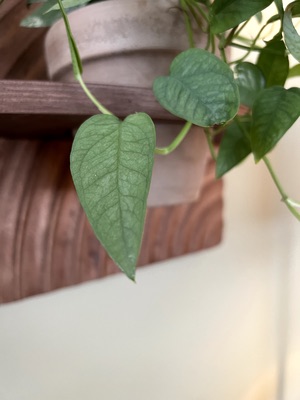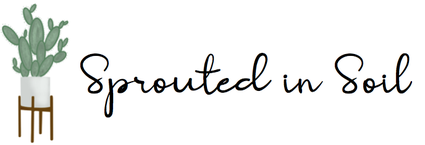The Cebu Blue pothos is a stunning variety of pothos with lush leaves that are much more slender than most other pothos plants. While their natural habitat is in the humid jungles of Southeast Asia, the Cebu Blue grows beautifully indoors.
Come and take a dive into this Cebu Blue pothos care guide to learn how you keep your plant looking fabulous.
Table of contents
The beautiful Cebu Blue pothos plant gets its name from the plant’s native habitat which is the stunning Cebu Island located in the Philippines. The lovely silver-blue hue of this plant also is indicated in its name. This houseplant is easy to care for and proliferates quickly!
Cebu Blue pothos plants are considered to be a type of evergreen vine variety. Epipremnum pinnatum ‘Cebu Blue’ is the Cebu Blue pothos’ scientific name in the Araceae family. While the plant grows naturally outdoors in its Asian homeland, it does surprisingly well indoors. It is also considered an invasive species outside of its natural habitat, so please be responsible and keep your Cebu Blue pothos as an indoor plant!
Quick Facts

- Common Name: Cebu Blue Pothos
- Scientific Name: Epipremnum pinnatum ‘Cebu Blue’
- Mature Size: trailing or climbing up to 8 feet long indoors
- Sunlight: bright, indirect light
- Water: when top 2 inches of soil are dry
- Soil: well-draining soil that holds onto moisture
- Temperature: 60°F-80°F with moderate humidity
- Propagation: leaves, cuttings
- Hardiness Zone: 9-12
- Toxicity: toxic to humans and pets
Growth Pattern and Habits
Unlike other pothos, Cebu Blue leaves have a crinkled texture. Because of this characteristic, the blue-silvery iridescence can sparkle and appear to glow in the right light!
Cebu Blue pothos has two different growth phases. These growth phases are termed juvenile and mature. A Cebu Blue can be identified in its juvenile growth phase by its oval shaped leaves that are thin, long and colored an attractive silvery blue.
A mature Cebu Blue pothos’ leaves will begin to change as it becomes more established. This happens most often when the plant is grown outdoors. The mature phase is characterized by its leaves which are much larger, a deeper forest green and the appearance of fenestrations.
The time it takes for this plant to mature is not precisely known but it can take upwards of twenty years. You may notice your mature Cebu Blue pothos developing split leaves. This phenomenon does not occur in all indoor Cebu Blue pothos plants, however there are a couple of ways in which to encourage the formation of fenestrations. Cebu Blue pothos fenestrations look very similar to the deep ones that are characteristic of Monstera deliciosas.

To promote split leaves on a mature Cebu Blue pothos, it is vital to train the plant to climb using a moss pole. This best mimics its natural growth habits. Optimal Cebu Blue pothos care, such as long exposure to bright indirect light, will also help encourage split leaves.
Sunlight
If you have other pothos plants, then you will be comfortable accommodating your Cebu Blue Pothos’ light requirements. Cebu Blue pothos thrive in bright, indirect sunlight. These plants can do ok in lower light conditions, however will show off their most vibrant color when they receive bright, filtered light throughout the daylight hours.
This could be achieved by growing the plant near an east facing window where it receives bright morning light, a west facing window with filtered early evening sun, or in a south facing window just outside of the sun’s direct rays.
Take care with exposure to long hours of direct sunlight especially in the hot and sunny afternoon hours as the Cebu Blue pothos leaves are prone to scorching.
Water
An appropriate watering schedule is crucial to Cebu Blue pothos care. Like most houseplants, your Cebu Blue pothos will need the proper amount and timing of water on a regular basis. Too much watering can cause the roots to rot damaging and weakening the plant. Over or underwatering your plant can leave it susceptible to other ailments like fungal growth, pest invasions, or bacterial infections.

Allow the topsoil to dry out thoroughly between waterings for best results. Use the top two inches of soil as your guide. Be sure to remove any shed leaves, and water the plant thoroughly holding the plant pot over the sink to allow excess water to drain out properly. Failure to do this step can result in your plant soil, and ultimately the plant itself, absorbing too much mineral and salt content that the water and soil normally contain.
Also, water the plant in the early morning hours to ensure that the plant and soil will not be soaking wet when in direct sunlight or later when in darkness to avoid burning your plant leaves or setting the plant up for mold growth. Water a bit less in the winter months when the plant is usually in a dormant stage.
Soil
The ideal soil content for a happy Cebu Blue pothos is a mixture of potting soil, perlite and orchid bark evenly divided. Use a potting soil that has a pH of about 6.1 to 7.8. The pearlite is primarily added to soil mixtures to increase the aeration of the soil which allows the plant to take up the proper amount of nutrients without getting compacted. A chunky soil texture is typically best for this plant to grow and orchid bark is the best choice.
While these recommendations will create the best environment in which to grow your pothos, Cebu Blue are not particularly picky and will be happy in any nutrient rich soil that is not overly dense or compact.
Allow soil to stay somewhat moist but not overly soggy. Your plant should be inside a proper planter pot with drainage holes in the bottom.
Temperature and Humidity
Since these plants are native to tropical environments and most of us don’t want to keep our house in greenhouse-like conditions, it’s ok to keep the temperature comfortable for you. Your Cebu Blue will do just fine!
The indoor Cebu Blue will do very well in normal household conditions and indoor temperatures of 60°F-80°F. Keep your plant away from colder areas or away from windows if the weather outside is chilly. Also make sure they are not grown close to heating and cooling vents.

Your Cebu Blue will thrive with an indoor humidity level of about 70-85 percent which is similar to the plant’s native habitat humidity levels. If your family prefers a lower humidity level indoors, place your plant near or in areas where there is increased moisture like a bathroom, laundry area or in a kitchen.
I do suggest increasing the humidity level slightly during winter months if you run a heater or furnace to help prevent plant dryness. This can be done using a small humidifier or placing the pot on a pebble tray.
Fertilization
Cebu Blue plants thrive best when the soil is enriched with nutrients and has a chunkier composition. To provide the best Cebu Blue pothos care and encourage prolific growth, add a bit of fertilizer on occasion especially in the plant’s first couple of growing seasons. Some potting soil mixtures for houseplants already contain a slow-release fertilizer so check your package first before adding additional mixtures.

These kinds of fertilizers are chock full of nutrients plants require, like calcium, nitrogen, phosphorus, potassium and magnesium among others. These mixtures usually contain micronutrients and macronutrients which describe how much of each ingredient is included in your fertilizer.
Dilute the fertilizer with water and follow the fertilizer instructions exactly to ensure that your plant does not get damaged by too much fertilizer.
Propagation
Cebu Blue pothos propagation is quite easy and is done using stem cuttings. When done correctly, your new Cebu Blue pothos should root and grow quickly.
- To propagate a Cebu Blue pothos, start by making small stem cuttings four to five inches long. When choosing an area of the stem to cut, be sure to include at least two nodes (little bumps along the stem). These are the spots from which roots, leaves or other stems can grow!
- You can either put these cuttings directly into new soil or first place in water then transfer to soil.
- If you choose to first place your cuttings in water, do so in a clear container so you can watch the roots form and monitor the water color. Water should only cover the bottom ⅓ of your Cebu Blue pothos cuttings. It should be replaced every two days to avoid bacterial or algae contamination. Once roots have appeared, you can then transplant the cuttings into soil.
- If you desire to go straight to putting cuttings into the soil, simply ensure that several nodes are buried into the soil. Keep soil moist and warm during this phase. Keep out of direct sunlight to avoid damaging the delicate new plant.
Common Issues
While caring for a Cebu Blue pothos plant is relatively simple and easy to do, there are some common issues that you should be aware of to avoid damage to or death of your plant.
Droopy, Soggy Leaves
If you notice leaves that are drooping and feel mushy to the touch, the culprit is most likely overwatering. Remember to check the soil before watering and only water when the top two inches of soil are bone dry.
An overwatered Cebu Blue pothos may also have yellowing leaves and discolored stems. This is a sign of root rot which is caused by chronic overwatering.
Dried, Shriveled Leaves
You can likely guess what causes this issue. If you guessed underwatering and/or too much direct sunlight, you are correct! The best light for a Cebu Blue pothos is bright but indirect light as this plant has tender leaves and stems that are easily burned.
Just as overwatering can be an issue, too much neglect in the watering department can cause the leaves to shrivel and sag on their stems. Chronic overwatering will cause your leaves to become dry and brittle.
Mealybugs
Mealybugs are small, white bugs that clump together on plants and feed off of the sap obtained from plant tissue. Mealybugs are the most common pest seen infesting a Cebu Blue pothos. You will notice small, cottony white speckles along stems and leaves.
To treat a mealybug problem, wipe away all noticeable signs of the insects with an alcohol soaked cotton ball. Spray with neem oil and continue to treat weekly until the infestation is gone.
Toxicity
The Cebu Blue pothos plant is toxic to young children and pets if they chew or put the leaves or other parts of the plant into their mouths. Keep this plant away from children and pets. Signs and symptoms of toxic poisoning from this plant include excess drooling, noticeable irritation, redness, swelling and pain in or near the mouth or possibly on the skin too.

Pets may develop foaming of the mouth. In rare cases, problems with breathing and/or vomiting may occur. Call your poison control center if you suspect contact with the plant has caused these symptoms.
Conclusion
I love that I have added a Cebu Blue pothos to my plant collection. The silvery, iridescent greenish-blue leaves are quite magical. They can be grown in hanging pots, allowing the stems to spill over the sides and cascade down in dreamy ringlets of leaves or can be trained to grow up a moss pole for an exotic look. Remember that using a moss pole will greatly increase the likelihood that your Cebu Blue pothos will have split leaves as it matures!
I hope this article has given you the confidence to properly care for your Cebu Blue Pothos. This type of pothos is slightly less common to find in plant stores than other varieties (especially if you see a Cebu Blue pothos with fenestrations!!), so if you see one, take the chance and use this care guide to help! Using the method above, propagate your Cebu Blue pothos to create a large collection of this stunning plant.




